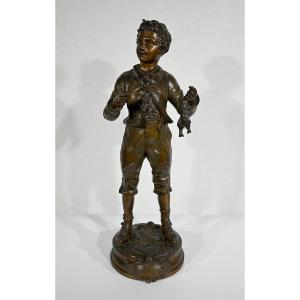- Slightly worn in places, base minimally bumped, otherwise in excellent condition
- Ready to strike -
The crusader gazes resolutely over his raised shield at the enemy, his confident posture indicating that he will not retreat in the least, defending the terrain with his tightly wrapped mace. The armor, slightly damaged on the left shoulder, bears witness to battles already fought.
However, the stance is not only a secure position, but also a purposeful retreat that turns into a lunging movement. The already tensed muscles are masterfully visible under the chain mail, anticipating the powerful blow. By dynamizing the figure in this way, Josef Moest succeeds in depicting the battle on the basis of the individual figure without illustrating the battle as such. The impression of the crusader's presence beyond the historical distance is reinforced by the extremely realistic details. The finely woven chain mail as well as the leather straps give a convincing impression of the actual material.
The positioning on the high pedestal lends the figure a monumental quality, giving a moral impetus to the inner attitude depicted.
About the artist
As the son of the Cologne sculptor, restorer and collector of medieval sculptures, Richard Moest, Josef Moest was born with an interest in sculpture. After training under the cathedral sculptor Peter Fuchs, he studied sculpture under Syrius Eberle at the Munich Academy from 1897 to 1902. Moest then opened his own studio. He quickly made a name for himself as a sculptor. He created high-quality salon sculptures and was involved in numerous church decorations. In 1904, he co-founded the Cologne artists' association “Stil”. In 1908 he took part in the exhibition at the Munich Glaspalast and in 1909 in the Great Art Exhibition of the Düsseldorf Academy. Suffering from tuberculosis, Moest designed a Pietà for his own grave in 1912, when he was just 39 years old, before he died two years later.


















































 Le Magazine de PROANTIC
Le Magazine de PROANTIC TRÉSORS Magazine
TRÉSORS Magazine Rivista Artiquariato
Rivista Artiquariato